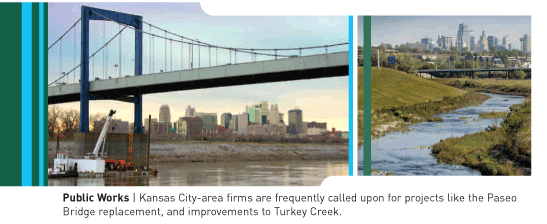likely to be only the beginning of transportation-and trade-related trends. In China, planning for trade goes so far as
to dictate that manufacturing is located within two days of a major port. Although such steps are unlikely here, other changes are likely.
“People talk about what’s the next vision beyond the interstate,” Smith said. “Eisenhower’s interstate serves as a good principal, but the industry is looking to see what is next. We need to get on that one quickly or it could hurt the global competitiveness of our manufacturing.”
Kansas City’s centrality has always been a blessing, but isn’t necessary for the region to continue its leadership. HNTB’s Smith said modern communications technology allows engineers here to talk with clients on either coast with relative ease. Using smart board and other technologies, they can view plans simultaneously with other engineers in Orlando or Seattle. Growing technology has helped Kansas City maintain its engineering dominance by reducing the need for decentralization.
“Communications allows us to have what we now call an integrated global workforce,” Mastalio said. “You can have people in Beijing, Kansas City and Alabama working on the same project. With standard processes and procedures coupled with robust communication, it really is an integrated workforce today.”
Advanced communications also allow exciting opportunities for Kansas City engineers. Mastalio cited a project in Australia that benefited from local expertise without the inconvenience of travel for Kansas City engineers. “Our professionals get a chance to work on things throughout the world without having to go there,” he said.
GROWING CHALLENGE
Still, there are challenges in the engineering world. Several industry leaders lament declining graduation rates at most of the nation’s engineering schools. “Overall, we’re barely keeping up with retirement and sometimes falling behind,” Graves said. “When you combine that with growing demand, nationally and globally, there’s a problem.”
Several leaders suggest the trend is a reflection of the nation’s decreasing emphasis on engineering, even basic math and science, since those fields peaked after Sputnik. “The lack of engineering and science begins in elementary school,” Mastalio said. “If the basics aren’t there, they won’t be able to go into.” He hopes a project with the Kauffman Foundation
and organizations such as Black and Veatch can help address the problem.
One response to the problem is to hire greater numbers of foreign-born engineers, including those who are educated in their home country, as well as at American schools. “That’s one reason you see engineering firms using more foreign nationals,” Marsh said. “Many have studied here, but there is some risk for us because of the limited number of work visas available. It’s a serious problem either way.”
The shortage could grow into a major national issue. “We need to make sure we have the right people in place with the right training,” Mastalio said. “It’s a pressure that’s on us as a society. You have to remember that everything you touch around the room has had an engineer working on it at some point. There’s nothing that doesn’t exist without that.”
Smaller but significant trends are also part of the profession’s future. Several top Kansas City firms are employee-owned, an arrangement that proponents say creates a positive dynamic.
“It allows you to participate in the success of the firm,” Marsh explained. “I think it makes us more motivated, although it’s also naïve to say that. Government employees and private-firm workers work hard. But reaping the benefits of your company means you think as an owner rather than just as a paycheck.”
The relatively large number of employee- owned firms could be due to the inherently creative bent of engineers, a group not often considered entrepreneurial, but who spend much of their time solving problems creatively. Employee ownership provides an advantage for clients who are not looking for a commodity.
“As a privately held firm you’re not whipped by Wall Street,” Marsh said. “You’re not driven by quarterly profits, so you can make long-term decisions. That’s a generalization, but I think that often we can take a longer view of what we do.”
NEW TOOLS
The future of engineering includes new methodology, especially areas like sustainability and the “green” revolution. “Unlike a lot of trends, this is no fad,” Graves said. “It’s critical to the future of our environment and our country. It’s critical that firms like mine take the lead.” Black and Veatch has spent $1 million on demonstrations at its Kansas City world headquarters, including a hybrid solar/lighting system that feeds sunlight directly into interior spaces.
Although the details are complex, green engineering is essentially the development of projects that have lower operation and maintenance costs. “If a project uses water, then you want it to use less water,” Curtis explained. “You want it to use less energy. But you also look at the overall life cycle. When this thing reaches the end of its useable life, can we recycle it rather than have something that’s considered hazardous or is difficult to recycle? That’s a big change in thinking.”
The advance of technology helps here. “It helps us address climate change,